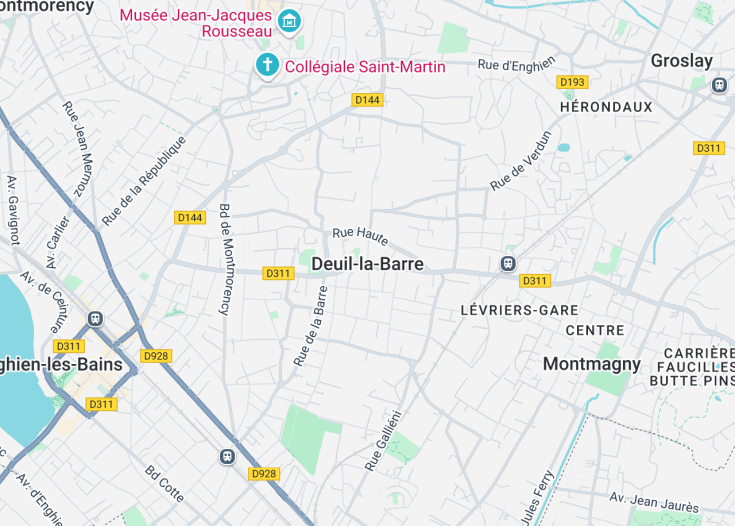Nestled in the Île-de-France region, Deuil-la-Barre is a charming commune offering a picturesque escape just north of Paris. Known for its serene ambiance and rich cultural heritage, this town provides an ideal blend of historical sites and tranquil natural spaces. Visitors can explore architectural marvels like the Saint-Louis church or stroll through the soothing pathways of its public parks. Deuil-la-Barre’s inviting community and elegant landscapes make it a perfect destination for those seeking a peaceful retreat from the urban rush.
Explore the local markets to savor traditional French delicacies. It’s a delightful way to immerse yourself in the culinary culture of Deuil-la-Barre.
Don’t miss a walk along the Montmorency Forest bordering the town; it offers refreshing trails and beautiful autumn vistas.
Top things to do & see in Deuil-la-Barre
Select the following sights and activities to discover best tickets and tours available in Deuil-la-Barre.
Deuil-la-Barre: A Suburban Gem Near Paris
| Country | France |
| Time in Deuil-la-Barre | GMT+1 |
| Language spoken | French |
| Population | 21,800 (INSEE, 2021) |
| Currency | Euro (€, EUR) |
| Airports |
|
Deuil-la-Barre, nestled in the northern suburbs of Paris, France, stands as a tranquil yet inviting community, contrasting the bustling city life of the capital. Renowned for its serene residential neighborhoods and picturesque parks, the town provides a peaceful retreat with convenient access to the urban amenities of Paris. Its historical roots trace back to the medieval times, reflected in the traditional architecture and preserved heritage sites.
Where is Deuil-la-Barre?
Deuil-la-Barre is located in the Île-de-France region, north of Paris. It is ideally situated for easy access to the French capital.
Distances:
| Route | Distance by car | Time by car |
|---|---|---|
| Paris to Deuil-la-Barre | 9.3 miles | 25 minutes |
| Orly to Deuil-la-Barre | 22 miles | 35 minutes |
| Versailles to Deuil-la-Barre | 21 miles | 45 minutes |
What is Deuil-la-Barre famous for?
Deuil-la-Barre is known for its charming historical architecture, green public spaces, and its close proximity to Paris, offering residents and visitors a quieter alternative to the capital’s dynamic atmosphere.
History
Prehistoric Times to Gallo-Roman Era
Deuil-la-Barre, now an emblematic locale within the Île-de-France region, has witnessed human activity since prehistoric times. Archaeological excavations reveal traces of early human presence, from flint tools to remnants of Gallo-Roman settlements. This area, during the Roman conquest, was strategically important due to its proximity to Lutetia (present-day Paris).
Medieval Period (5th to 15th Century)
The documented history of Deuil-la-Barre begins in the medieval period when it was referred to as “Dolium”. It involved into a small village centered around agriculture and viticulture, benefiting from its fertile land. The introduction of Christianity brought significant ecclesiastical influence, culminating in the construction of the Saint Didier Church in the 13th century.
Early Modern Period (16th to 18th Century)
During the Renaissance and through the early modern period, Deuil-la-Barre saw modest growth. The village was part of the Montmorency seigniory, and the lords played a pivotal role in its development. The 17th century saw the construction of several impressive manor houses as Parisian aristocrats sought rural retreats close to the capital.
19th Century to World War II
The advent of the industrial age brought about significant changes. The construction of the North Railway in the 19th century linked Deuil-la-Barre to Paris, facilitating easier commutes and trade. The town gradually transformed from a primarily rural community into a suburban area. World War II left its mark with several historical residences being utilized for various military purposes.
Post-War Period to Present
In the aftermath of World War II, Deuil-la-Barre experienced rapid urbanization. The population grew significantly as people moved from Paris and other parts of France seeking suburban comfort. Modern developments and infrastructure projects have been carefully balanced with the preservation of its rich historical and cultural heritage, making Deuil-la-Barre a unique blend of the old and the new.
Visit Deuil-la-Barre
What to see and do in Deuil-la-Barre, France
Deuil-la-Barre offers a rich tapestry of cultural and historical sights coupled with serene natural spots. Ensure to visit:
- The Saint Didier Church, dating back to the 13th century, stands as a testimony to medieval architecture.
- Walk through the historic Rue Charles de Gaulle, lined with quaint shops and traditional bistros.
- Explore the lush green spaces of Parc de la Chevrette, perfect for a leisurely walk or a picnic.
- The local market, held on Wednesdays and Saturdays, where you can sample local produce and crafts.
Recurring events in Deuil-la-Barre
Deuil-la-Barre hosts several cultural events and festivals throughout the year, enhancing its community spirit. Noteworthy are the Spring Arts Festival in April and the Heritage Days in September, both offering a deep dive into the town’s rich cultural fabric.
Best time to visit Deuil-la-Barre
The best time to visit Deuil-la-Barre is between late spring and early autumn, from May to October, when the weather is most pleasant, and the town’s events are in full swing.
Is Deuil-la-Barre worth visiting?
Deuil-la-Barre offers a charming escape from the bustling city life of Paris, with its rich history, peaceful green spaces, and a strong sense of community. While it might not boast the grandiose attractions of larger cities, its cultural events, historic sites, and local markets provide a genuine French suburban experience. The town is particularly appealing to those seeking a quieter visit with a touch of historical exploration. However, those looking for high-energy nightlife or major tourist attractions might find it less thrilling. Overall, Deuil-la-Barre is worth visiting for those appreciating subtle beauty and historical charm.









